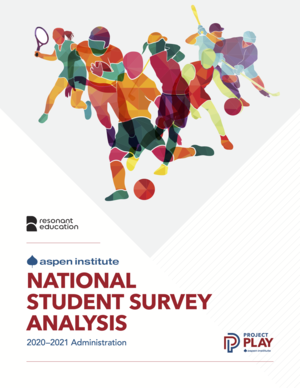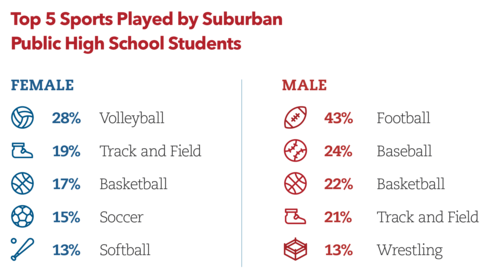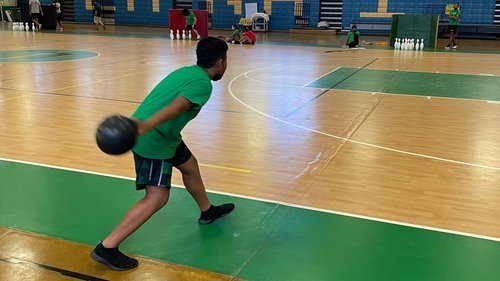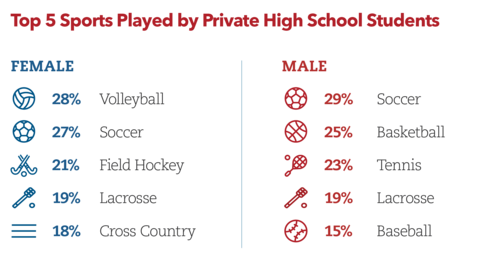The supply of sport options provided by high schools is not meeting the demand for them, and the menu needs to be updated to include more casual and fitness-focused activities, according to a new national student survey released by the Aspen Institute and Resonant Education.
Read complete analysis from Project Play, Resonant Education here.
Archery, which only 1% of students have ever tried, was the sport they most wish was offered by their school. Thirteen percent of all surveyed students, both athletes and non-athletes, expressed interest in trying archery, followed by gymnastics, lacrosse and bowling (7% each).
When asked what additional physical activities outside of interscholastic teams that students would like to participate in, strength training (35%) was the No. 1 choice, followed by biking (24%), skateboarding (21%), yoga (21%) and climbing (20%). Males showed a higher interest in strength training and parkour, and females favored yoga and dance.
The findings are part of a comprehensive report showing results from a national high school student survey conducted during the 2020-21 school year. The survey, created by Resonant Education in collaboration with the Aspen Institute’s Project Play initiative, asked students about their participation in sports as well as other perceptions about high school sports.
Over the past year, Project Play’s Reimagining School Sports initiative has studied ways to make quality sport and physical activities accessible to all students. Eight reports highlight strategies school leaders in different school types and urbanicities can use to grow participation, with $20,000 prizes awarded to eight high schools that display innovative and exemplary ideas. The national student survey findings will help guide Project Play’s recommendations on how to improve the high school sports model when a final report is released in March 2022.
Nearly 6,000 students responded to the anonymous, online survey from schools representing all regions of the country as well as different school types (public, private and charter) and urbanicity (urban, suburban and rural). The results provide critical insight from both before and during the COVID-19 pandemic of high school students’ needs, interests and attitudes related to sports and physical activity.
Below are some additional findings from the Aspen Institute/Resonant Education survey:
ALL STUDENTS
Winning and scholarships ranked low as motivations to play. The most common motivations students said for playing high school sports were having fun (81%), exercise (79%), learning and improving skills (66%), playing with and making new friends (66%), and competing (64%). Multiple answers were allowed. Winning games (53%) and pursuing college scholarships (39%) ranked lower. Black students (50%) were more likely than other races and ethnicities to cite scholarships as a motivation for playing. Males showed higher rates for winning games and competing than females. Females were more likely to report mental health and well-being, belonging to a group and improving college applications as reasons they play sports.
Schoolwork impacts sports participation. Among students who don’t play sports, the most common reason for not playing was schoolwork (42%). Females listed schoolwork as a barrier more than males, and Asian students said the same more than any other race or ethnicity. Other reasons cited by all students: not enjoying sports (32%), not having sports that are of interest (26%), and not trying out because students didn’t think they were good enough to make the team (25%).
Opinions of coaches decline as students advance in age. As students got older, they were less likely to agree with statements such as “Coaches at my school value every member of the team” and “Coaches at my school have positive relationships with all of their players.” This shift may reflect differentiated treatment in upper grades for stronger members of the team as students reach higher levels of competition, such as playing varsity instead of junior varsity. Students gave the lowest marks to athletic personnel for encouraging multisport play and educating them on good nutrition.
URBAN PUBLIC SCHOOL STUDENTS
High school basketball participation rates are lower at urban schools. Basketball carries a well-earned reputation as an urban sport, but fewer urban males (18%) reported having played high school basketball than males at rural (28%) and suburban (22%) schools. Urban girls played basketball at a lower rate than rural girls. And White, Black and Hispanic students at urban schools played high school basketball at lower rates than their same race or ethnicity in rural and suburban communities. Basketball was among the top 10 sports all urban students said they wish their school offered. Increasingly, they attend smaller schools that lack gyms.
Urban students rely on community programs as much as school teams. For example, urban students participated on track and field, soccer and football teams outside of school more than suburban and rural students. Urban students were twice as likely to report they planned to participate in track outside of school than their peers. Interestingly, the highest rate of male cross-country runners came from urban schools (18%), not suburban (12%) or rural (9%) communities that offer more undeveloped land for running. Black students expressed the most interest in trying gymnastics, whereas White, Hispanic and Asian students most favored archery, which has seen exponential growth among high schools over the past decade.
Many students feel they aren’t good enough to play sports. In urban settings, many students arrive in high school behind the curve in sports knowledge and skills. Almost one-third of ninth-grade urban students (32%) said they don’t play high school sports because they are not good enough, compared to 23% of ninth-grade suburban students. The older they get, the more urban students said they don’t enjoy sports (24% of freshmen vs. 35% of
SUBURBAN PUBLIC SCHOOL STUDENTS
Costs to play sports add up. Males at suburban public high schools, which often require participation fees, were three times more likely than urban males to identify expense as a reason they don’t play sports. Suburban females (18%) also listed costs as a barrier more than urban females (11%).
Hispanic students lack offered sports that interest them. Among suburban students who don’t play high school sports, 26% of Hispanics said they sit out because no sports offered by the school interest them. That was twice the rate of Hispanic students at urban and rural schools who said they were not interested in their school’s offered sports.
Demand for fitness activities and yoga is strong. Males (44%) and females (33%) at suburban schools reported they work out at gyms at higher rates than their peers. The older they are, the more suburban students said they work out (28% in ninth grade vs. 44% in 12th grade). One in three female suburban students said they were interested in trying yoga, with 16% of all freshmen expressing interest compared to 31% of all seniors.
RURAL PUBLIC SCHOOL STUDENTS
Rural students have highest participation rates. Students at rural schools reported the highest rates of participation in basketball, softball and track and field, and more frequently take part in other physical activities, such as walking/hiking, pickup games, jogging and swimming. Football was especially popular among Black rural students (42%) compared to Black students at suburban (27%) and urban (25%) schools. More than half (58%) of Hispanic rural students reported they have played soccer, above the national average for all Hispanic students (39%). All rural students (71%) also said they enjoyed PE more than all surveyed students (62%).
Transportation is a major challenge. Rural students were twice as likely as students from urban areas to cite transportation as a reason they don’t play sports more often. Rural students were also the most likely to indicate they don’t play due to jobs, family responsibilities or their disability was not accommodated to play sports.
Winning, family pride and feelings of inferiority show up. Winning games and making their family feel proud mattered slightly more to rural students – especially among girls – than students elsewhere. On the other hand, rural students were also slightly more likely to report they didn’t try out for a team because they don’t believe they are good enough.
PRIVATE SCHOOL STUDENTS
Scholarships are not the driving motivation for participation. The chase for the college athletic scholarship wasn’t among the top 10 reasons private school students said they play sports, a notable finding given the national reputation that some private schools have in sports like basketball and football. Private school students (27%) were less likely to cite scholarships than public school students (42%). Private school students were more likely to participate for exercise, to make new friends, to belong to a group, and to support their mental health.
Students of color and different gender, sexual preferences feel less welcome on teams. Among private school students who don’t play sports, 25% of Blacks and 40% of Hispanics said they “don’t feel welcome” on school teams. That was five times greater than Black students at public urban schools and almost twice the rate of Hispanic students at public urban schools. Also, 8% of private school students said they avoid sports because “I don’t feel safe because of my gender identification or sexual preference” – twice the rate of public school students.
Private schools offer less PE and prioritize sports that can be played for life. More than half of private school students (58%) said they have never taken PE in high school compared to 14% of public school students. Only 15% of male students said they play football at private schools, less than half of the national average (33%) and below that of tennis (23%). More than twice as many boys at private schools reported playing soccer (29%) than boys at suburban public schools (12%).
CHARTER SCHOOL STUDENTS
Charter students want more sports. Students in charter schools, which have proliferated over the past couple decades, were more likely to report that they wanted more options for sports and fitness activities. Requests included a desire for swimming and football – sports more often found in traditional public schools – as well as bowling, gymnastics and dance. Charter students reported higher participation rates in traditional sports like soccer, basketball and volleyball compared to traditional public schools and private schools.
But charter students lost the most interest during COVID-19. Eighteen percent of charter school students said they lost interest in playing sports during the pandemic. That was slightly higher than students at public (16%) and private (13%) schools. Charter students tended to report greater barriers, such as fewer sports offered, transportation and too much schoolwork.
PE helps develop sports interest. Among charter school students, 10% said that trying a sport in PE made them want to play that sport at school. That doubled the national average. Charter students reported a greater level of education on nutrition, especially compared to private school students.
Jon Solomon is editorial director of the Aspen Institute Sports & Society Program and its Project Play initiative. Read all the Reimagining School Sports reports here. Findings, strategies and opportunities developed through the Reimagining School Sports initiative will be explored at the Project Play Summit in Washington D.C. Register here to attend.


















